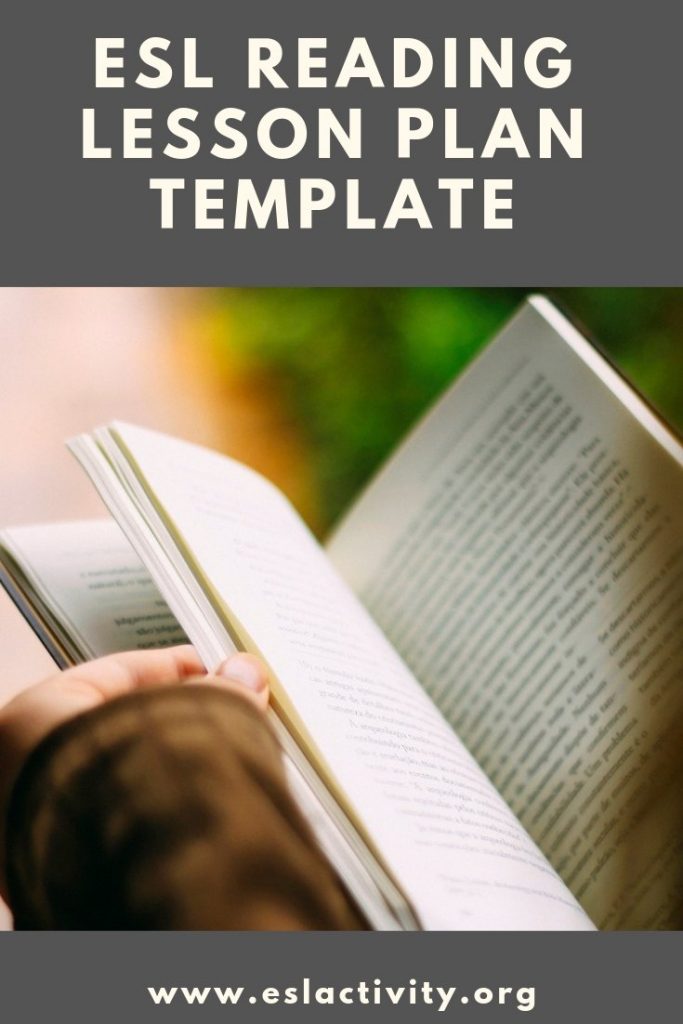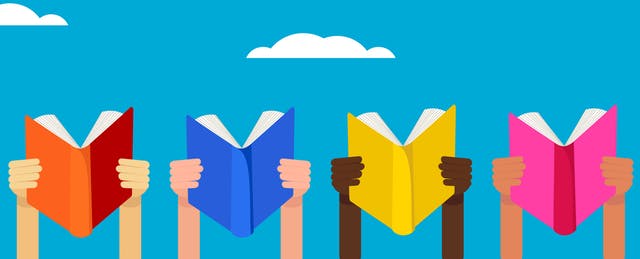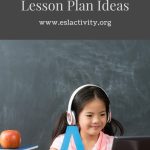If you’re looking for everything ESL reading lesson plan template, then you’re in the right place. We have an easy system for you to follow, as well as sample ESL reading lessons to consider. Keep on reading!

ESL reading lesson plan
Lesson planning: are you solid on how to do them, or not so much? If not, then have a quick read-through of this ESL reading lesson plan template. This reading lesson plan template also works well for listening lessons.
Reading skills are very important for our students. This lesson plan will help your students improve their reading fluency, as well as reading comprehension. Read more for all the details about ESL reading lessons. You’ll be a pro in no time at all!
Planning a Reading Lesson Plan: It’s Not Easy Without a Template
I’m always surprised when I get reader questions or talk to people preparing for their upcoming ESL job interviews that they don’t know how to make a basic lesson plan. But, it’s not so crazy I guess and I actually had no system of any sort until I took the CELTA course a few years back.
The ESL reading template that I’m going to share with you today is modelled after that and it can provide you with a solid foundation upon which to expand and adjust to suit the needs of your own classes.
(If your classes are focused on speaking, check out this ESL Speaking Lesson Plan Template).
There are five basic ESL lesson plan steps for a class focused on reading that I’ll describe below.

ESL lesson plan template for reading
7 Steps for an ESL Reading Lesson Plan
There are a few distinct steps you can follow when teaching reading skills. Although the reading passage changes, the steps do not!
First of all, be clear about the objectives of your lesson. That is, what is the lesson trying to achieve and what will success for the students look like?
Step #1 for Teaching English Reading: Set the Context
Context is everything when learning a language and it’s a key component of Swiller’s Cognitive Load Theory. Without it, our students are just learning random bits of grammar and vocabulary but they don’t have a way to put it together into a cohesive system within their brains.
To start you lesson off, you’ll need to do this, 100% of the time. A great teacher never forgets this! And of course, the context for each lesson will change from day to day so don’t use the same old stale thing, okay?
ALWAYS help your students by providing as much context as possible either by activating prior knowledge (works well with reading or listening lessons). You can also give your students situations in which they can use the language (vocabulary or grammar lessons).
An easy way to do this in a reading or listening lesson is to have students talk together for a couple of minutes about something. During the CELTA course, I had this story about a man who was living in an airport. I was lucky, perhaps, in that it was something that the students were really interested in! In order to set the context, I had students talk about five things that people do when they have to wait in the airport for a long time (sleep/watch TV/eat + drink, etc.).
Step #2: Pre-Reading Task
This is where you have students do something related to the reading. You can teach/have students review some of the key vocabulary in the passage, or do something like a prediction task.
In the case I mentioned previously, I told my students that they were going to read a story about a guy who lived in an airport for 17 years. And that he only left eventually because he got sick and had to go to the hospital. The students had to guess why they think he stayed there so long.
I elicited five answers and wrote them on the board to lead into step #3, making sure that one of the answers was the correct one.
- Amazon Kindle Edition
- Bolen, Jackie (Author)
- English (Publication Language)
- 88 Pages - 02/16/2020 (Publication Date)
Step #3: Gist Reading Task for the Text
You should always have students read for gist. This is because it gets them out of the extremely bad habit they often have of reading every single word in excruciating detail. When people read in their first language, they never read all the words. Instead, they just skim or scan the page to look for the information they need.
You need to help your students get practice doing this in English. It’s also useful if they’re doing any sort of English examinations because they often contain quite long reading passages which students have to digest in a limited amount of time. It can really help them if you teach them how to read and only look for specific information.
For the airport example, I gave students only two minutes and they had to quickly skim through the passage to find out why the man stayed in the airport for so long. Always have students compare answers with each other and then check as a class. But, this is a gist reading task so give the correct answer but do NOT go into any sort of depth. Students will have another chance in the next task to catch all the nuances of the passage.
Step #4: Main Reading Task for the Text
This is the middle or the heart of the lesson.
This is where students take a more detailed look at the reading and can read more slowly and carefully. You can give them some short answer, True/False questions, etc. However, at this stage, I try to break students of another bad habit: always looking at their cell-phone dictionaries. I tell them that they can use it only one time, but otherwise, they can just guess and use the surrounding context to give them some clues.
Students compare answers with a partner or small group and then you can check together as a class. You can go into a bit more depth with explanations at this stage if necessary.
If you want to give your students a little quiz to test their comprehension, you may wish to do this story timeline activity.
You could also work on some pronunciation at this time if there are any problem words.
Step #5: Application
In this ESL lesson plan stage, students take the ideas and go a bit deeper with them. For the airport example, I had students work together with a partner to think of five interesting questions that they’d ask the man if they had the chance to meet him in person.
After that, I had one person pretend to be a journalist while the other one had to be the man in the airport. The journalist conducted an interview and made sure to ask a few follow-up questions as well.
I finished off the lesson by talking about what eventually happened to the man (I looked it up on the Internet).
Step #6: Homework (Optional)
You may wish to assign some homework to your students as a way to follow-up. Or, add some optional worksheets to your online tool for students to use if they’d like to.
Step #7: Post-Reading Activities
You may wish to include some post-reading activities in your classes. These can extend an hour-long class into a two-hour one for example. Or, you may wish to do it over two classes. Some of the things you can do with your students are to have them think more deeply about the characters or plot.
Or, you may want them to:
- Find examples of a certain part of speech (common adverbs, or if you’re teaching articles ESL, then 10 examples of those)
- Search for examples of a certain grammar point (simple past or subject/verb agreement)
- Look for metaphors and similes
- Do some worksheets
- Watch some videos about the same topic
- Listen to some related songs
- Something fun (get creative!)
- Do some kind of writing activity
- Etc.
More ideas here: ESL Reading Activities.
Additional Resources for Teaching English Reading
You can learn more about this here: Post-Reading Activities for English Learners.
Many of these can be done without a teacher. Gift your students the ability to improve their reading skills on their own!
- Amazon Kindle Edition
- Bolen, Jackie (Author)
- English (Publication Language)
- 75 Pages - 05/31/2020 (Publication Date)
You may also want to check this out: Easy Books for English Learners.
Reading Lesson Plans FAQs
There are a number of important questions that people have about planning reading lessons. Here are the answers to some of the most common ones.
What is the Aim of a Reading Lesson?
The aim is what teachers hope that learners are able to achieve in a course or lesson. Activities should be planned with the aims in mind. A reading lesson aim could be to learn new vocabulary, notice some key grammar points, or to work on a reading sub-skill like scanning/reading for gist, or reading for comprehension.

Reading lesson aims and goals
Can I Adapt this ESL Lesson Plan Template for my Own Purposes?
Isn’t it a good idea to make a lesson plan my own? Maybe, but maybe not.
Of course you can feel free to do whatever you want in your own classes (as long as it’s okay with the school). Some things may work for you, while others may not.
That said, if you’re just starting out, it can be valuable to stick pretty closely to the steps in this lesson plan sample. It’s a proven system that many, many teachers around the world have been using for years and is taught in the CELTA/DELTA courses. It’s backed by some solid education theory about learning languages.
Once you get a bit more experience, then consider adapting it to your own style, section by section. You know what works best for you, and your students. It’s a big world out there and no two students are the same! The best teachers can adapt.
Does this Style of Reading Class Work for Any Level of Student?
That’s another great question! This template assumes that your students have a basic level of English reading, and are able to do things like compare answers with their partner. It’s best for at least high beginners and then can work on up to advanced level students (more ideas here: Advanced ESL Lessons).
For students who are struggling with basic reading skills or vocabulary, you’ll want to focus on that first before worrying too much about comprehension.
Can I Use This ESL Lesson Plan Template for Children?
This style of lesson works better for high school students or adults than is does younger children. It assumes that students are able to do things like compare answers with a partner, or have a short discussion for a lead-in or warm-up.
Younger kids, sometimes this stuff doesn’t work that well. However, you can adapt the lesson to make it more teacher-centred and it will still work. Get the students to share their answers with you and the entire class instead of with a partner for example.
Where Can I Get News Articles for ESL?
If you want to design your own sample ESL lesson plan, then you’ll need to start with an article of some kind. It can be difficult to find good materials that are appropriate for the level of your students. This is particularly true if you teach beginners.
The good news is that there are lots of online resources out there with plenty of good stuff. Graded readings, comprehension questions, listening exercises and more awesome stuff. They’ve done the hard work of content development for you, in making the news into something your ESL students can read.
You can check out my top picks here: The Top ESL News Article Websites.
What are the ESL Reading Skills?
Here are some of the most common ESL sub-skills for reading that you might want to focus on for your students:
- Skimming
- Scanning
- Reading for gist
- Making predictions
- Reading for detail
- Fluency
What Topics Should I Choose for ESL Reading Lessons?
This reading lesson plan sample lends itself well to just about any topic under the sun. Seriously, the sky is the limit.
However, here are a few things to keep in mind when planning an ESL reading lesson plan.
Choose Timeless Topics
If I’m going to put the time and effort into planning an ESL reading lesson, then I want to be able to use it again in the future.
This means that I choose timeless, or evergreen topics that are of interest to a wide group of people and ages. If I do this, I’ll have plenty of opportunities to recycle the lesson in the future. Social science usually has a wealth of good stories, material and topics that lead to a great conversation.
Once you plan a few of these reading lessons, you’ll have a variety of go-to lessons you can pull together very quickly.
Use Google Drive
In order to recycle your reading lesson plans effectively, use Google Drive. You can go in there, make a few quick changes and have your “new” lesson ready to go in just a few minutes.
Base your Lesson Plan on an Article
Of course, a reading lesson should be based on an article of some kind. This is obvious, but it’s worth noting. You can find them online, or in textbooks.
Don’t be Afraid to Adapt the Language
If you want to talk about a certain topic, but can’t find an appropriate article, don’t be afraid to take one and adapt the language. I usually do the following:
- Shorten the article
- Remove complicated vocabulary and terms
- Take out complicated grammatical constructions or parts of speech
Keep the Reading Short
Unless you have a class that is 3-4 hours long, you’ll want to keep the reading reasonably short. In general, it shouldn’t take students more than 1/5 of the class time to read the article.
Sure, you can assign it for homework, but many students won’t complete it so I like to give class time for this.
What are the Seven Strategies of Reading?
In order for anyone to read more effectively, whether native English speakers or English learners, they should practice a mix of the seven following reading strategies. They include activating, monitoring or clarifying, interfering, questioning, searching or selecting, summarizing and visualizing or organizing.
Do you have any ESL Reading Lesson Plans that I Can Check Out?
If you’re looking for some examples of how this looks in real life, then you’ll want to check out these lessons plans that I’ve designed, and then used in my own classes, mostly with South Korean teenagers, university students and adults.
Check out these reading lesson plan examples right here:
6 Lesson Plans for Advanced ESL Students: These lessons usually start off with a reading, and then get into speaking, conversation, writing or listening. Some are for students in any country, while others are specific for students in South Korea.
Everything ESL Lesson Plans: Find out more about ESL reading lesson plans, along with ones for speaking, listening and writing classes.
Renewable Energy Reading Lesson Plan (For intermediate or advanced levels students): This lesson starts off with a reading passage, and then gets into some grammar, vocabulary and conversation work.
What is an Intermediate Reading Level?
English learners at the beginner level may have difficulty with pronunciation and comprehension of new vocabulary when reading. However, students at an intermediate reading level are able to infer the meaning of unrecognized vocabulary items from context and usage.
What is the Definition of Reading Comprehension?
Reading comprehension means that the reader is able to process a text to understand the meaning of it, as well as integrate this knowledge with what they already know. This requires a text at an appropriate level so that the reader isn’t using too much of their capacity to understand individual words which can interfere with the bigger picture.
H0w to Teach ESL Students to Read?
If you teach ESL beginner students and want to teach them how to read, here’s some solid advice:
More ESL Reading Lesson Plans
Do you want some reading lesson plans that you can just print off and use in your classes? You’re in luck! There are a ton of excellent resources online that’ll save you so much time when planning lessons. Here are some of the best ones to consider:
Do You Like this ESL Lesson Plan Template?
You’ll probably enjoy this book as well: 39 ESL Warm-Ups for Teenagers and Adults. Get your classes started off on the right foot with these low-prep activities and games that your students will love. It can be difficult for students if you jump right into the heart of the lesson. Instead, ease them into English with a fun activity.
This book is all about making your life easier. You should be able to find a warm-up that’ll work for your level of students and topic in under a minute. If you can’t? Well, get in touch and I’ll personally refund your money.
Available in a Variety of Formats
The good news is that the book is available in both print and digital formats. You can keep a copy on the bookshelf in your office as a handy reference. Or, take a copy with you on your phone for lesson plans on the go at your favourite coffee shop.
Where Can I Find the Book?
Check it out for yourself over on Amazon, but only if you want to get yourself a serious dose of ESL awesome in your life, okay?
More Tips for Planning ESL Reading Lessons
Planning an ESL reading lesson requires careful consideration of the students’ language proficiency, reading skills, and learning objectives. Here are some tips to help you effectively plan an ESL reading lesson:
Determine the Learning Objectives
Clearly define the specific reading skills or objectives you want your students to achieve. This could include improving vocabulary, comprehension, inference, critical thinking, or reading fluency.
Select Appropriate Texts
Choose texts that are suitable for your students’ proficiency level and age. Consider their interests and ensure the content is engaging and relevant. Authentic materials or graded readers can be used depending on the students’ reading abilities.
Pre-Reading Activities
Engage students in pre-reading activities to activate their prior knowledge and build background information related to the text. This can include brainstorming, discussing related topics, or using visuals to generate interest and introduce key vocabulary.
Set a Purpose for Reading
Clearly communicate the purpose of reading to students. It could be to find specific information, understand the main idea, identify key details, analyze characters, or make predictions. This helps focus their attention and gives them a goal while reading.
Introduce New Vocabulary
Identify any challenging vocabulary in the text and pre-teach or provide contextual support for these words. Use various techniques like visuals, real-life examples, or vocabulary exercises to help students understand and remember the new words.
Reading Comprehension Strategies
Teach and model reading comprehension strategies such as predicting, summarizing, inferring, questioning, and visualizing. Help students develop these strategies to enhance their understanding and critical thinking while reading.
Interactive Reading
Encourage active participation during the reading process. Use techniques like think-pair-share, group discussions, or reading circles to promote interaction, collaboration, and comprehension checks.
Post-Reading Activities
Engage students in activities that reinforce comprehension, vocabulary acquisition, and critical thinking. These can include comprehension questions, summarizing, retelling, analyzing the text, or connecting it to real-life situations.
Differentiate Instruction
Consider the diverse needs and abilities of your students and provide differentiated activities or materials. Offer additional support for struggling readers and extension tasks for advanced learners.
Assessment and Feedback
Assess students’ reading comprehension through various means like quizzes, written responses, or oral presentations. Provide constructive feedback to guide their improvement and offer opportunities for reflection.
Have your Say about Planning an ESL Reading Lesson
Do you have any tips or tricks for an ESL lesson plan template? Or, tips for ESL lesson plans in general? Leave a comment below and let us know what you think. We’d love to hear from you. And be sure to contact us if you have any questions about teaching English.
Please give this article a share on Facebook, Twitter, or Pinterest. It’ll help other teachers, like yourself learn more about an ESL lesson plan template resource.
Check out the rest of this blog for lots more helpful games and activities for teaching English, as well as templates for other styles of lessons besides working on ESL reading skills.
Last update on 2022-07-17 / Affiliate links / Images from Amazon Product Advertising API









